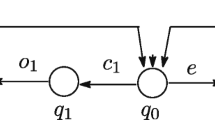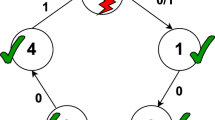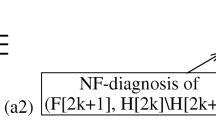Abstract
We study the effect of communication delays on the performance of a coordinated decentralized architecture for failure diagnosis of untimed discrete event systems. The architecture consists of local sites communicating with a coordinator that is responsible for diagnosing the failures occurring in the system. A protocol that realizes the architecture is defined by the diagnostic information generated at the local sites, the communication rules used by the local sites, and the decision rule used by the coordinator to infer the occurrence of failures. Our prior work (Debouk et al., 2000) has addressed the performance of a set of protocols under the assumption that messages are received by the coordinator in the order in which they are sent globally. In this work we relax the abovementioned assumption. We modify the coordinator's decision rule for two of the protocols analyzed in Debouk et al. (2000) to account for the reception of out of order messages. We discover conditions on the system structure under which the modified protocols perform as well as the centralized diagnostic scheme proposed in Sampath et al. (1995).
Similar content being viewed by others
References
Aghasaryan, A., Fabre, E., Benveniste, A., Boubour. R., and Jard, C. 1998. Fault detection and diagnosis in distributed systems: An approach by partially stochastic petri nets. Journal of Discrete Event Dynamical Systems: Theory and Applications, August, 203-231.
Baroni, P., Lamperti, G., Pogliano. P., and Zanella, M. 1999. Diagnosis of large active systems. Artificial Intelligence 110: 135-183.
Bertsekas, D., and Gallager, R. 1992. Data Networks. Englewood Cliffs. NJ: Prentice Hall.
Deb, S., Mathur, A., Willett, P., and Pattipati, K. R. 1998. Decentralized real-time monitoring and diagnosis. In Proc. IEEE Gonj. on Systems, Man and Cybernetics, October, 2998-3003.
Debouk, R. 2000. Failure Diagnosis of Decentralized Discrete Event Svstenis. PhD thesis, Electrical Engineering and Computer Science Department. The University of Michigan. Available at http://www.eecs.umich.edu/umdes.
Debouk, R., Lafortune, S., and Teneketzis. D. 2000. Coordinated decentralized protocols for failure diagnosis of discrete-event systems. Journal of Discrete Event Dynamical Systems: Theory and Applications 10: 33-86.
Fabre, E., Benveniste, A., Jard, C., Ricker, S. L., and Mark Smith. 2000. Distnbuted state reconstruction for discrete event systems. In Proc. 39th IEEE Conf. on Decision and Control, December 2252-2257, Sydney, Australia.
Holloway, L., and Chand, S. 1994. Time templates for discrete event fault monitoring in manufacturing systems. In Proc. /994 Anierican Control Conference 701-706.
Mohindra, S., and Clark, P. A. 1993. A distributed fault diagnosis method based on digraph models: Steady-state analysis. Computers and Chemical Engineering 17(2): 193-209.
Pencolé, Y. 2000. Decentralized diagnoser approach: Application to telecommunication networks. In Proc of DX'2000, Eleventh International Workshop on Principles of Diagnosis, June, 185-192.
Pouliezos, A. D., and Stavrakakis, G. S. 1994. Real time fault monitoring of industrial processes. Boston, MA: Kluwer Academic Publishers.
Ricker, S. L., and Fabre, E. 2000. On the construction of modular observers and diagnosers for discrete-event systems. In Proc. 39th IEEE c'onf. on Decision and io,itrol, December, Sydney, Australia.
Sampath, M., Sengupta. R., Lafortune, S., Sinnamohideen, K., and Teneketzis, D. 1995. Diagnosability of discrete-event systems. IEEE Trans. Automat. Contr. 40(9): 1555-1575.
Sampath, M., Sengupta. R., Lafortune, S., Sinnamohideen, K., and Teneketzis, D. 1996. Failure diagnosis using discrete-event models. IEEE Trans. Contr. Syst. Tech. 4(2): 105-124.
Sengupta, R., 1998. Diagnosis and communication in distributed systems. In Proc. of WODES 1998, International Workshop on Discrete Event Systems, 144-151, August. London, England: lEE.
Stark, W. E., Wang. H., Worthen, A., Lafortune, S., and Teneketzis, D. 2002. Low energy wireless communication network design. IEEE Wireless Communication Magazine, August 60-72.
Schmid, U., Guest Editor. 1997. Special issue on global time in large scale distributed real time systems. Real Tinie Systems 12(1, II, and HI): 1-351.
Willsky, A. 1996. A survey of design methods for failure detection in dynamic systems. Automatica 12: 601-611.
Author information
Authors and Affiliations
Rights and permissions
About this article
Cite this article
Debouk, R., Lafortune, S. & Teneketzis, D. On the Effect of Communication Delays in Failure Diagnosis of Decentralized Discrete Event Systems. Discrete Event Dynamic Systems 13, 263–289 (2003). https://doi.org/10.1023/A:1024007808984
Issue Date:
DOI: https://doi.org/10.1023/A:1024007808984




